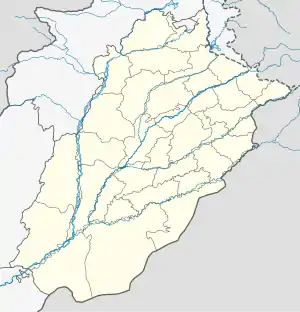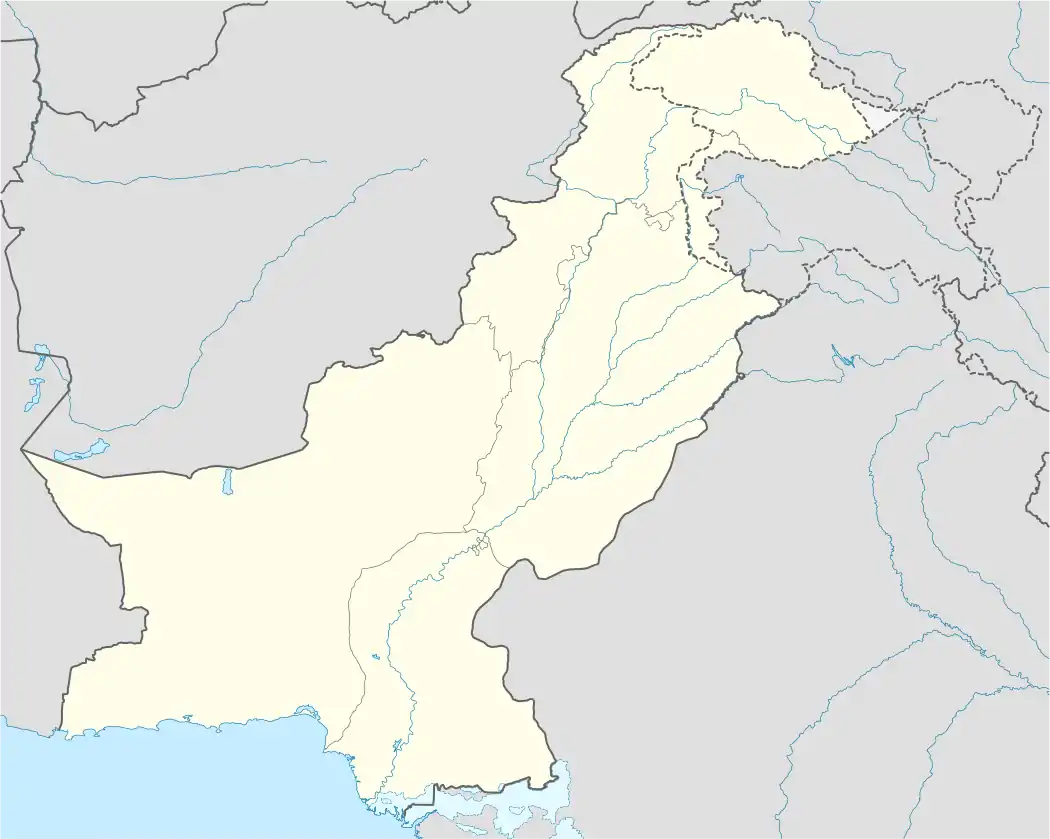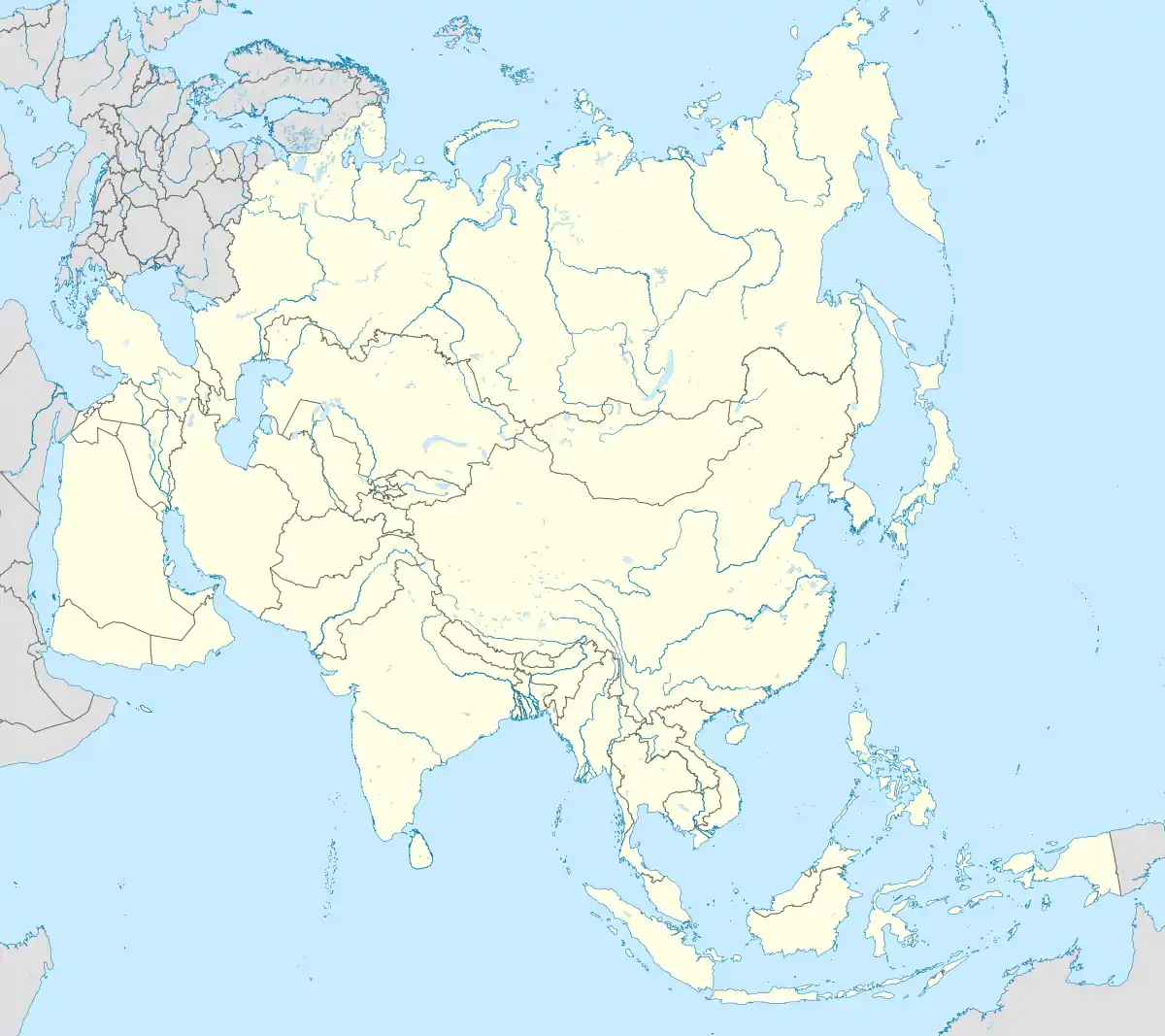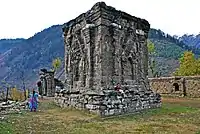Prahladpuri Temple
Prahladpuri Temple (Urdu: پرَہْلادْپُورِی مندر) was a Hindu temple located in Multan city of Punjab province in Pakistan, adjacent to the Shrine of Bahauddin Zakariya. Named after Prahlada, it is dedicated to the Hindu deity Narasimha.
| Prahladpuri Temple پرَہْلادْپُورِی مندر | |
|---|---|
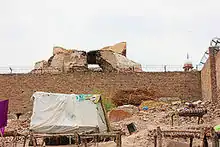 Ruins of Prahladpuri Temple | |
| Religion | |
| Affiliation | Hinduism |
| District | Multan |
| Deity | Prahlada |
| Festivals | Holi |
| Governing body | Pakistan Hindu Council |
| Location | |
| Location | Multan |
| Country | |
| Geographic coordinates | 30°12′01.3″N 71°28′36.6″E |
| Architecture | |
| Type | Hindu temple |
The temple is presently in ruins, since its destruction in 1992 by a Muslim mob in retaliation for the demolition of the Babri Masjid in Ayodhya, India and the site is currently owned by Evacuee Trust Property Board.[1][2]
Architecture
The temple is located on top of a raised platform (mandapa) in the southern tip of the Fort of Multan, adjacent to the venerated tomb of Baha’ul Haq Zakariya.[2] Prior to being demolished, the temple featured a main hall, and circumlocutory passages adorned with skylights.[2] The hall continued to feature a replica of the idol under a baldachin.[2]
History
Pre-colonial India
The temple stands on the ruins of pre-Muslim structures.[2] There were older temples on the site which were razed before being re-constructed or refurbished during the medieval era — however, the precise details are hazy in light of conflicting chronicles and legends.[2] Originally, the place might have had housed the famed Sun-temple of Multan.[3][lower-alpha 1]
One version of oral legend hold that a temple— a columnar structure with the roof and columns made of pure gold—used to exist around the 15th century before being dismantled by Sher Shah Suri to construct a mosque.[2] The new temple was constructed, when this mosque fell down.[2][lower-alpha 2] Another account published in Calcutta Review (1891) invokes the same description of the pre-existing temple but here, it had sank in the ground of "unknown causes" necessitating the construction of present structure.[4]
Colonial India
In 1810, the height of the temple was significantly raised (or, was the temple rebuilt - ?), which led to tensions with the Muslim community.[5][2] Alexander Burnes, during his visit in 1831, noted the temple to be a structure of low height, supported by wooden pillars and having Hanuman and Ganesha as portal-guardians; he was denied entrance.[2][6] It was remarked to be the only place of Hindu worship in Multan.[2][6] An annual festival used to be held in the premises on the anniversary of Narasimha's appearance.[7]
During the 1848 Siege of Multan, a shell fired by forces of East India Company fell on a gunpowder store within the fort and blew away the roof of the temple.[7][8] Post-siege, the East India Company retained total control of the fort and all adjoining areas (incl. shrines) for some years before returning them back to native communities, upon a petition.[2] A condition was imposed in August, 1852 to the effect of disallowing Hindus to approach the temple via precincts of Zakariya's shrine in lieu of being allowed to refurbish the temple.[2] Alexander Cunningham, visiting the site in 1854, found the temple to be a roofless "square brick building with some very finely carved wooden pillars", and the only Hindu shrine in Multan alongside Suraj Kund.[2][7] In 1859, another mutual agreement was reached upon by both communities to not incorporate conspicuous additions to either site.[2]
Two years later, the Chief Mahant of the temple, Baba Ram Das raised about Rs.11,000 by way of public donation and refurbished the temple.[2] In the early 1870s, Baba Narayan Das proposed to raise the height of the temple-spire to 44 ft —which was more than that of the adjoining shrine— with donations from Thakur Dawara Fateh Chand Tanksalia and other Hindu citizens.[2] This was opposed by local Muslims as a breach of the 1859-agreement, fomenting an acrimonious dispute.[2][lower-alpha 3] The local administration had to intervene and the issue was decided in favor of the Muslims; an agreement enacted on 14 April 1876 restricted the height to 33 ft.[2] However, the Hindus were not content and sought for scopes to get it vacated.
Multan Riots
In August 1880, the Mahant finally obtained consent from local civil and military authority to install the 45 ft. spire, as planned.[9] Constructions went on for about three months, before the Mahdoom of the tomb moved a petition against the construction before Cordery, the Commissioner of Multan.[9] Cordery investigated the dispute and based on his reports, Lt. Governor Egerton decided to not only reinstate the limit of spire-height at 33 ft. but also asked Hindus to cede with possession of the compound well and a piece of land.[9] This led to the Hindus appealing for a reversal before Viceroy Ripon.[9][lower-alpha 4]
C. August 1881, a committee composed of six people each from both camps was set up to arrive at a compromise.[9] Before their discussions went anywhere, the town got enmeshed with the communal tensions fomenting across Punjab against the backdrop of Arya Samaj's cow-protectionist movements.[10][11] The question of transport to, and sale of beef in Multan town turned into an affair of competitive communalism.[9]
On 20 September 1881, a riot erupted and spanned over two days, resulting in 50,000 rupees worth of damage; no lives were lost.[10][12] Hindu rioters burned a mosque in the city's bazaar, attacked the Walli Muhammadi Mosque, and burned a Quran.[13] A Muslim mob retaliated about 2 hours later, arsoning the Prahladpuri temple in particular.[13] The entire contingent of British troops from Multan Cantonment had to be dispatched to control the mobs.[12] On 29 October, the Government finally decided to not dismantle the spire but as a compensation, granted the sole possession of well and ownership of a nearby land to the Muslims.[14]
The temple was quickly renovated by the Hindu community and continued to be managed by them.[15]
Beyond riots
In the early morning of 7 November 1912, unknown miscreants removed an image of Lakshmi and threw it in a nearby well, after stealing the crown; local Muslims were blamed by the Hindus.[16] On 23 January 1913, the incumbent Mahant was removed by a Panchayat of Hindus in what led to protracted litigation.[lower-alpha 5] In 1930, Times of India reported a mass-congregation of Hindus and Muslims, who gathered from Prahladpuri Temple and Multan Eidgah respectively, on the occasion of Peshawar Day to partake in a hartal against the British government.[17]
Post-colonial Pakistan
After the creation of Pakistan, most Hindus migrated to the newly independent Republic of India but the affairs of temple continued to be managed by the few remaining Hindus of city.[1] However, the management was soon taken over by the Evacuee Trust Property Board (henceforth, ETPB) in whose hands, it fell into a state of neglect; a madrasa got established inside the temple premises.[18][19]
Despite, the building continued to be a prominent landmark in Multan and even, a dharamshala was opened adjacent to the site.[2]
Destruction and aftermath
In 1992, the temple (as well as the dharamshala) was destroyed by a Muslim mob in retaliation for the destruction of Babri Masjid in Ayodhya, India; local Hindus associated with the temple were also targeted.[1][2] It has been in ruins ever since.[2] As of 2006, lower levels have been occupied by squatters and garbage is regularly dumped at the site.[2] A survey authorized by the Ministry of Culture determined a risk of imminent collapse of all remnant structures.[2]
Proposed Reconstructions
In May 2015, ETPB announced its plans to restore the temple and in August, granted a fund of 5 million PKR to Punjab Archeology Department for the purpose.[20][21]
In December 2020, a one-man commission was established by the Supreme Court of Pakistan to interrogate into the status of minority religious shrines.[22] The report was submitted in February, urging for the immediate restoration of Prahladpuri Temple along with three other temples (a bevy of policy-changes were proposed as well); accordingly, Chief Justice Gulzar Ahmed ordered the State of Punjab as well as ETPB to ensure optimum preparedness of the shrine for Holi festival.[22][23][24]
Soon afterwards, the Multan government and other local bodies announced plans to restore the temple as part of a broader project in ensuring religious harmony.[25][26][27][28]
Folklore
In Hindu folklore, the original temple was built by Prahlada —son of the Asur-king of Multan—[lower-alpha 6] in honor of Narsing Avatara of Vishnu, when he appeared out of a pillar to disembowel Hiranyakashipu and reward Prahlada's devoutness.[2][29] The temple was constructed around the pillar.
Consequently, the festival of Holika Dahan is assumed to have started there.[1]
See also
Notes
- With a golden statue embellished with jewels, this temple-compound was frequently mentioned by multiple travelers — Xuanzang (614 AD) and others. Despite speculations, the precise location of the temple remains unknown.
- Publications of the local archaeological dept. argue that since Jean de Thévenot mentions of a temple "on this very site" during his visit in 1665, Suri's mosque must have been put to disuse within about a century of its construction which is highly unlikely given its royal antecedents.[2] Thus the authenticity of the narrative is doubtful.[2] However, Thévenot never provides any information on the precise location or architecture: the shrine is only described to have featured an unknown black god in red clothes with pearl eyes, attracting pilgrims from far and wide.
- For a rather graphic description, consult Boyle, Frederick (1884). "A Bit of an Old Story". On the Borderland. London: Chapman and Hall Limited. pp. 377–397.
- The Amrita Bazar Patrika of 11 August 1881 (p. 1) reports the Government to have informed the Hindus of Multan about their intentions to "shortly issue an order" on the dispute.
- This serves as an interesting example of the powers exerted by the community: the Mahant was dismissed on grounds of addiction to charas, refusal to shelter migrant fakirs, inappropriate conduct with women, and inability to maintain a record of temple donations. Ajudhia Das challenged the dismissal before the Magistrate of First Class, arguing the position of Mahant to be hereditary and beyond the powers of Panchayat but failed to get any favorable judgement.An appeal was filed at the Lahore High Court in 1917 and the judgement was pronounced on 1 August 1922. Das' dismissal was sustained on rather-technical grounds —he had set up adverse claims to the property in the meanwhile, thus running afoul of Chintaman v. Dhondo— but the Panchayat actions were opined to be unjustifiable irrespective of its legal validity.
- Multan is believed to have been founded by sage Kashyapa. The name Kashyappur is located in several ancient sources.
References
- "Archived copy". Archived from the original on 2013-12-11. Retrieved 2012-04-10.
{{cite web}}: CS1 maint: archived copy as title (link) - "Archived copy". Archived from the original on 2015-01-07. Retrieved 2015-01-07.
{{cite web}}: CS1 maint: archived copy as title (link) Survey & Studies for Conservation of Historical Monuments of Multan. Department of Archeology & Museums, Ministry of Culture, Government of Pakistan - Suvorava, Anna (2004). "The Spiritual Sovereign of Multan". Muslim Saints of South Asia: The Eleventh to Fifteenth Centuries. London: Routledge. p. 153. doi:10.4324/9780203592717-8. ISBN 9780203592717.
- "The Early History of Multam". Calcutta Review. Vol. CLXXXIV. April 1891. p. 241.
- Punjab (India) (1976). Extracts from the District & States Gazetteers of the Punjab, Pakistan: Punjab (Pakistan). Research Society of Pakistan, University of the Punjab.
- Burnes, Alexander (1834). "Chapter V". Travels into Bokhara. Vol. 3. London: John Murray, Albemarle Street. pp. 115–116.
- Cunnngham, Alexander (1875). ARCHAEOLOGICAL SURVEY OF INDIA VOL.5. The Superintendent of Government, Calcutta. pp. 126, 129.
- Monuments of Multan Archived 2016-02-01 at the Wayback Machine Survey & Studies for Conservation of Historical Monuments of Multan. Department of Archaeology & Museums, Ministry of Culture, Government of Pakistan
- Hindu Correspondent (7 October 1881). "The Mooltan Riot and its Causes". Times of India. p. 2.
- Roseberry, J. Royal (1987). Imperial Rule in Punjab: The Conquest and Administration of Multan, 1818-1881. Manohar. ISBN 978-81-85054-28-5.
- Chatterjee, Arup K. (2016-08-10). "Today's Cow Vigilantism Grew Under Inadvertant Aegis of the Raj". TheQuint. Retrieved 2021-10-11.
- Ross, David (1883). The Land of the Five Rivers and Sindh: Sketches Historical and Descriptive. Chapman and Hall, limited. p. 100.
prahladpuri temple riot -1992 -babri.
- Proceedings - Punjab History Conference. Publication Bureau, Punjabi University. 2000. ISBN 9788173807220.
- Times of India. 29 October 1881. p. 5.
{{cite news}}: Missing or empty|title=(help) - AIR 131 (Lahore High Court 1923).
- Own Correspondent (9 November 1912). "Sacrilegious Budmashes". Times of India. p. 8.
- Own Correspondent (3 May 1930). ""Peshawar Day" at Multan: Hindu-Muslim Procession". Times of India. p. 11.
- Khalid, Haroon. "Both colour and memories of Holi have faded from Pakistan's Multan, where the festival was born". Scroll.in. Retrieved 2021-02-22.
- Khalid, Haroon. "These temples in Pakistan are now madrasas". Scroll.in. Retrieved 2021-02-22.
- "ETPB to rebuild historical temple in Multan". www.thenews.com.pk. Retrieved 2021-10-11.
- "Grant approved for restoration of Prahladpuri temple". The Balochistan Times. Vol. XXXVIII, no. 216. Quetta: AsiaNet Pakistan (Pvt) Ltd. 7 August 2015.
- Mohan, Geeta (February 8, 2021). "Pakistan: Most Hindu worshipping places in country neglected, says SC-appointed commission". India Today. Retrieved 2021-02-22.
- "Pakistan SC Orders Immediate Reconstruction of Vandalised Hindu Temple". The Wire. Retrieved 2021-02-22.
- Reporter, The Newspaper's Staff (2021-01-05). "Commission suggests opening of four temples for tourism". dawn.com. Retrieved 2021-02-22.
- https://www.sci.gov.in/pdf/JUD_2.pdf
- Qureshi, Raiq (2021-02-15). "Multan peace committee takes multiple initiatives for restoration of Holi-origin Prahladpuri temple". Associated Press Of Pakistan. Retrieved 2021-02-22.
- Reporter, The Newspaper's Staff (2021-02-13). "Hindu council to host festivities at Parlhad Mandir next month". dawn.com. Retrieved 2021-02-22.
- Ali, Muhammad (2021-02-16). "A view of ruins of ancient Prahladpuri Temple. The restoration work on ancient Prahladpuri temple is likely to commence in next few days. Holi, the festival of colours, very much popular in Hindus, commenced from this Prahladpuri temple. The temple is located near the shrine of great saint of sub-continent Hazrat Bahauddin Zakariya RA". Associated Press Of Pakistan. Retrieved 2021-02-22.
- Maclagan, Edward (1926). Punjab District Gazetteers: Multan District 1923-24. Vol. VII. The Superintendent Government, Lahore. pp. 276–77.
